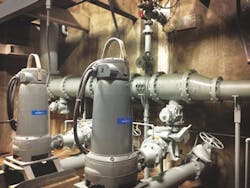Ada Township, Mich., can trace its roots back to 1821, when fur trader Rix Robinson built its first trading post. It is interesting to speculate what Robinson—undoubtedly a resourceful man—would have made of a problem Ada Township recently experienced with its main pump station.
The township (population: 13,000) is located several miles east of Grand Rapids in Kent County. The township owns and operates its own sanitary sewer collection system and is responsible for all maintenance and replacement. The wastewater collection system is comprised of approximately 143,000 ft of pipe, of which approximately 37,500 ft is 12 in. diameter or larger pipe size. The majority of the collection system flows by gravity to a pump station, where it is sent to the city of Grand Rapids, which provides wastewater treatment services on a contractual basis. Total flow is approximately 1 mgd.
Ada’s main pump station, which serves both residential and industrial customers, had become unnecessarily complex over the years. For example, the pumps had so many moving parts that they had become increasingly expensive to maintain. Each pump assembly consisted of the following: the pump; a seal pot mechanical system connected to an air compressor; couplings; extended shafting with pillow block bearings; shaft guards; vertical electric motors on the top floor; and hydraulically actuated check valves.
The old pumps were constantly under repair. Seals were failing and vibrations were so bad that the pumps had to be held down with sand bags. The pumps had seal pots that kept the pressure above discharge, but an air compressor system was required because the pots would frequently need to be recharged.
No Good Vibrations
General maintenance alone was a headache, but when excessive vibration and seal failures began to occur repeatedly, Ada Township knew it required a new approach to the problem or its budget was going to take a major hit because of increasing maintenance and costly repairs.
After huddling with its consultant, Moore & Bruggink, located in Grand Rapids, Mich., Ada and its engineering firm contacted Kennedy Industries for assistance. Located in Milford, Mich., Kennedy has been providing pump, valve and control services since its founding in 1959.
Working off its experience with Xylem’s dry pit submersibles, Kennedy recommended the installation of three Flygt model 130 hp NT-3315s to deliver 1,400 gpm at 205 ft of total dynamic head.
The pumps were changed out one unit at a time by the township’s mechanical contractor, Northwest Kent Mechanical of Cedar Springs, Mich. The contractor first removed one of the old pumps, shafting, pillow block bearings, guards, seal water pots, seal water piping, air compressor lines, air compressor and vertical motors on the upper floor. Installation was easy because these dry pit submersibles do not require a seal water system, coupling, shafting, guards, or any other auxiliary items.
The pumping assembly is designed for continuous operation in either a non-submerged or fully submerged environment. The motor is inverter-rated per NEMA MGI, Part 31, and is available as premium efficient. Variable frequency drives and air cushioned check valves also were added. A hard iron (25% chromium) impeller and insert ring are standard on all the company’s pumps, ranging from 12 to 105 hp. This provides up to 10 times better wear resistance when compared to standard cast iron, alleviating any concerns about grit and sand in the pumped media.
Slashing Maintenance
The dry pit submersibles also provided maintenance advantages over the township’s existing pumps, saving the township $5,000 to $6,000 annually, which was the previous cost for unscheduled visits to the main pump station. The dry pit submersibles feature:
N-technology impellers. These impellers are self-cleaning, raising efficiency and reducing unplanned maintenance visits. Stringy fibrous material and modern trash that enter the inlet of a conventional pump often get caught on the leading edges of the impeller vanes, reducing efficiency and increasing power consumption. In addition, should solids continue to build inside the impeller, motor thermal protection can trip and cause the pump to stop, all of which leads to expensive unplanned service calls. The efficiency of the N-pump is sustained over time due to its self-cleaning ability.
Inspection chamber. To increase operational reliability, an inspection chamber between the seal unit and the bearings enables rapid spot checks and maintenance. In the case of a seal failure, a built-in sensor provides an early warning of any fluid build-up, thus reducing the risk of expensive repair work.
Active Seal. The Active Seal system is a zero-leakage, double-seal system that actively prevents liquid from entering the motor cavity, thereby reducing the risk for bearing and stator failure. It is comprised of an inner seal that acts as a micro-pump and an outer seal that prevents leakage of pumped media into the buffer chamber.
Finally, since the new pumps are submersible, if the station floods, they would remain undamaged, unlike the previous pumps. And operator safety has been dramatically improved since they no longer have to maintain 25-ft-long shafting or frequently remove the pumps for repair.
Greasing motor and pump bearings, shaft maintenance, and shaft U-joint alignment and balance all are tasks of the past. Ada Township now is the owner of three new submersibles that run smoothly and quietly. In fact, an operator once reached into his pocket and pulled out a nickel. He then stood it vertically on end while the pump was running. Hours later, the nickel was still in the exact same position. The dry pit submersibles will provide the township with reduced maintenance and no unnecessary repairs for years to come.

